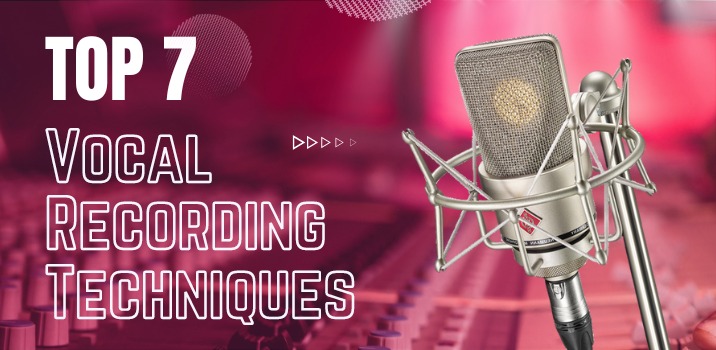Top 7 Vocal Recording Techniques

31-Jan-2024
For most recorded music, especially pop and hip-hop, vocals are the focal point and the last touch of your masterwork. Your track should be ready to shine at this point, provided you took great care during the recording process. So, how do you record the ideal vocal performance? Here, are the top seven vocal recording techniques, following which, you can get killer vocal tracks.
1. Using the Right Mic Is Essential
First and foremost, you should spend on the right kind of microphones. It is the first crucial component of the recording chain. Selecting the right vocal microphone is crucial to getting a high-quality, distinct voice on your recording medium.
Generally, you will want to use a high-end, large-diaphragm condenser microphone to record your vocal tracks. These microphones are generally more effective at capturing the entire spectrum of vocal nuances. However, artists have used dynamic microphones to produce amazing effects. For example, singers like Michael Jackson and Bono used reasonably priced dynamic microphones.
2.Have Proper Room Acoustics
Room acoustics is another crucial factor in getting excellent results at the beginning of your signal chain. Your recording space's sound has a big influence on the sonic signature of your recordings, even though it's frequently ignored. Sadly, the acoustic environment in the majority of home studios is subpar, which is why many recording projects fail at the first hurdle. The ridiculous thing is that even with a limited budget, poor acoustics are completely avoidable.
A free fix would be to drape a duvet behind the performer. This common trick will help keep unwanted reflections from reaching the microphone. Besides, you can also use dynamic microphones. Since it has lower sensitivity than a condenser mic, you can achieve a larger direct-to-ambient sound ratio.
3. Consider Headphone Mix
As part of ensuring the vocalist is comfortable, it should be taken into consideration to ensure they can hear the mix. It can save you hours of retakes or editing later on if you take a few extra minutes to make sure they can hear the track. A small amount of reverb added to one's mix can help certain singers hear more clearly and achieve better pitch accuracy. Remember to use your monitor mix with a good pair of closed-back headphones to help stop signal leaking back into the microphone.
4. Consider Using Pop Filters
Pop filters are necessary when using a condenser microphone to stop unwanted explosive consonants from warping the capsule. Once more, the most crucial part of any signal chain is the input stage. Stated differently, it is far preferable to make the necessary corrections now rather than trying to perform corrective surgery later on. In addition, once explosive consonants are recorded, they are extremely difficult, if not impossible, to remove. Thus, if you don't already have one in your recording toolkit, you really should.
5. Avoid Sibilance
High-frequency 'S' and 'T' sibilants can ruin an otherwise excellent vocal take. To reduce the sibilance, specialty compressors, de-essers, are employed, with differing degrees of success. A better option is to select a good microphone and place it strategically to reduce annoying sibilance noise in the first place. If this doesn't work, try a different microphone or move the microphone slightly above or below your mouth. To find the ideal microphone and placement for your singer and application, some trial and error is always necessary.
6. Delay the Effects For Later
These days, there are so many amazing effects that it can be tempting to patch one, two, or even more into your vocal recording session. However, it's generally a good idea to record vocals without effects and add them later if needed. Keep in mind that effects are nearly impossible to remove or even lessen once they are printed onto a track. For this reason, it would be ideal to record the vocal in its raw form on tape or a hard drive, then add effects during mixdown. But there are exceptions to this rule. To reduce overly high peaks, you might occasionally want to run the vocals through a limiter or compressor.
7. Practice, Practice, Practice!
Practice is the most important thing, and no amount of sophisticated recording techniques or plug-ins can replace it. Before pressing the "record" button, the singer should, to the greatest extent possible, be fully versed in the lyrics and capable of delivering a confident and compelling vocal performance.
We've all seen movie scenes where singers enter the recording studio, listen to a few bars of music, and record the vocal performance of their dreams. In actuality, these kinds of incidents are incredibly uncommon. The best performances typically result from a deep familiarity and understanding of the theme, melody and lyrics. This is possible only with a lot of practice.
Conclusion
Thus, mastering the craft of vocal recording involves experimentation and self-discovery. The real magic occurs when you discover the special blend of these seven techniques that complements your voice and style. These techniques are stepping stones towards producing vocals that sound professional. Now, grab your microphone, arrange your workspace, and start the thrilling journey of using these time-tested methods to capture the true essence of your voice.